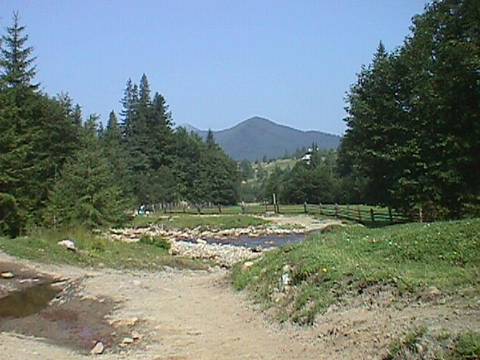Bukovina

Bukovina

Bukovina, a picturesque area of the Ukraine, is often
referred to as "the beech-land" for the name Bukovina stems from the Ukrainian
"buk" which means "beech." This ancient land of the Slavs has preserved
numerous monuments of history. It is mentioned in the chronicle:
"And ulichi and tivertsi sat on the Dniester in the vicinity
of the Danube; and there were thousands upon thousands of them, their land
stretching from the Dniester as far as the sea."
The ancient town of Vasyliv once stood on the very farthest border of Kievan Rus and challenged the beauty and architectural perfection of neighbouring Galich, the capital of Galician-Volhynian principality. Chern, which subsequently grew into the modern town of Chernivtsi, was founded in the 12th century on the crossroads of major trade-routes, and today the horseshoe pattern of the ancient town's fortifications can be seen.
For more than four centuries, Northern Bukovina was incorporated into Old Rus state; in the 10th through 12th centuries, this area served as a stronghold on the south-west frontier of Kievan Rus; until mid-14th century it was included in the Galician-Volhynian principality. For almost 300 years, Bukovina, then a part of Moldavian principality, was ruled by the Ottoman Empire and forced to labour under the hard Turkish yoke. In 1774 the area was annexed by the Austrian Empire. It was only the Khotyn Uyezd that in 1812 entered the Russian state. Austrian colonizers ruled Bukovina until 1918.
Throughout many centuries the population of Bukovina
fought for social and national independence. At different times, scores
of forceful anti-feudal uprisings were staged in the area, including the
one in 1490Ч1492 lead by Mukha;
another in the mid-17th century lead by Myron Dytynka, still another
in the 1730sЧ1740s headed by Olexa Dovbush; and the one in 1843Ч1848 headed
by Lukian Kobylytsia. Later, with the maturing of the proletariat, the
struggle acquired a political character; many strikes and rallies were
held in support of the Russian Revolution of 1905Ч1907.
In 1915Ч1917 Bukovina was the scene of some First World War battles. In 1918 Soviet power was proclaimed in the Khotyn Uyezd.
On November 3, 1918, the People's Assembly of Bukovina, consisting of 40,000 representatives, expressed the wish "to unify the Austrian part of the Ukrainian lands with the Ukraine."
In 1919 a determined protest against the Boyar Roumanian
occupation of Bukovina grew into a massive uprising in Kho-
tyn and an uprising at the 113th regiment in Chernivtsi.
On June 28, 1940, Bukovina was added to the Soviet Union. But the peacetime labour was halted by the attack of fascist Germany.
In the spring of 1944, Bukovina was liberated from fascist invaders.
Within a short period of time the Chernivtsi Region has grown into one
of the most developed areas.
Since August 24, 1991 Ukraine is independence
country.

Bukovina is famous for fiery dances, moving songs, skilful woodcarvings and needlework. Its native composers and singers are well-known in this country and abroad: for example, the composers Stepan Sabadash, Volodymir Ivasyuk, and the singers Dmytro Gnatyuk, Sofia Rotaru, Vasyi Zinkevych, Nazary Yaremchuk. The poet Mykhailo Tkach and film producer Ivan Mykolaichuk are also famous.
Visitors to the Bukovina area cannot but admire Chernivtsi, with its architectural ensembles, the town of Khotyn, with its fortress, stretching wide on the picturesque slopes of the Dniester, the Carpathian town of Vyzhnytsia over the Chere-mosh, the woody mountain pass of Nymchich, the mysterious Dovbush cave, the Tsetsyn nature preserve near Chernivtsi, or the mountain meadows of Yarovytsia. And of course, you are sure to like the songs of this land Ч lyrical and gentle, or sincere and fiery like the souls of the people who inhabit this land.

„ерн≥вц≥(укр) Ѕуковина - м≥й р≥дний край (укр) BUKOVINA(engl) »горешкина страничка